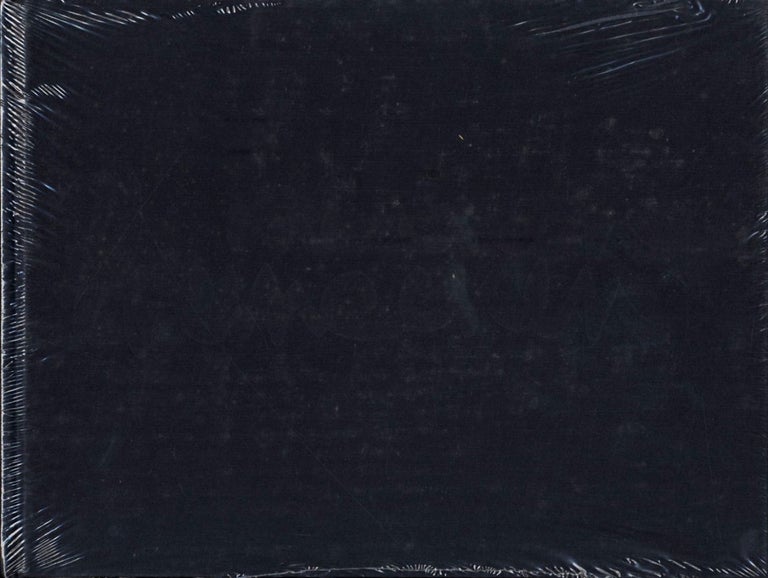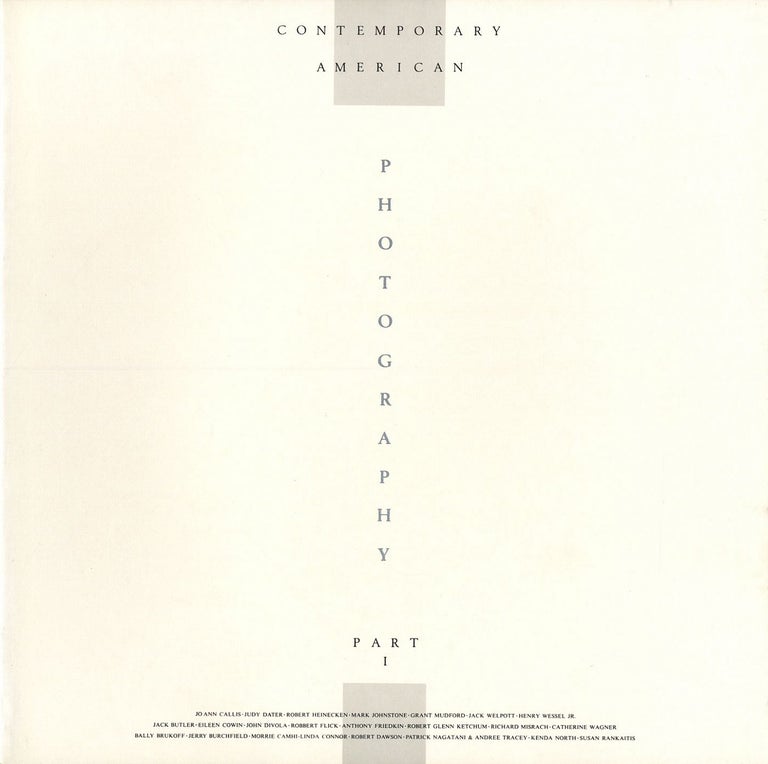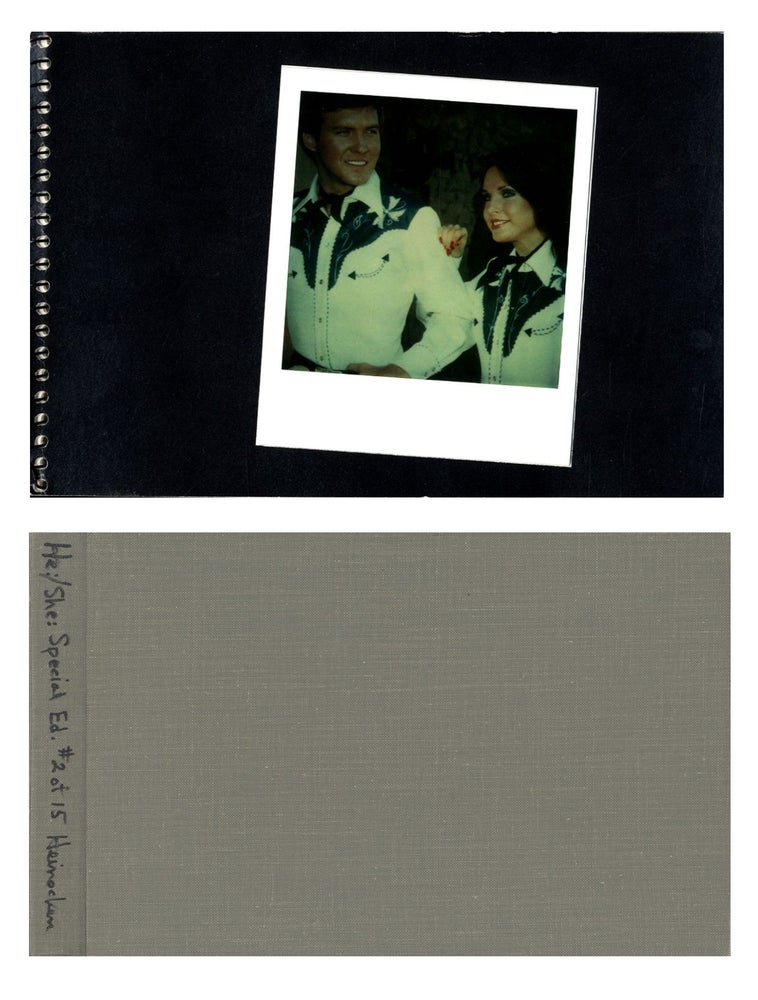Robert Heinecken: Just Good Eats For U Diner, Limited Edition (Portfolio of 8 Lithographs) [SIGNED]
Publisher: Los Angeles: Robert Heinecken, 1971
Edition: 1st Edition
Binding: No binding
Condition: As New / No dust jacket as issued
Item #: 111626
$7,500.00
Specifics
First limited edition of 100 copies (this being number 41). Signed and numbered 41/100 and dated "Los Angeles Nov 71" in pencil on the lower right corner recto the first sheet by Heinecken. Artist's portfolio of eight offset color lithographs and a descriptive text sheet in the form of a classic diner menu on matt art paper; sandwiched between two identical screenprinted reproductions of a 1968 cowboy kitsch painting by "Grandee," mounted to heavy cardboard; all contained in a clear vinyl envelope with black sewn vinyl edges and decorative brass corner grommets and an additional grommet along one edge that is, according to the artist, "provided for wall hanging." "Documentary Photograms" [of food] and faux menu text by Robert Heinecken. 13-1/8 x 11-1/2 inches. Out of print. Very scarce.
Condition
As New.
Description
From the artist: "This suite of eight original lithographs were printed by the artist using the offset method. The work represents five typical feeding times of the American middle class. Breakfast, Coffee Break, Lunch, Cocktails and Dinner were selected as the U S of A table d' hôte. The original skiagraphic images were made by exposing actual foods/meals to light sensitive materials, which were then transferred to aluminum plates. The final lithographic prints are on Rives heavyweight paper in black and (chocolate) brown ink. They consist of various food/meal combinations resulting from an exploration of the aleatory nature of the printing phase. Each of the portfolios in the edition of 100 were made from the same initial set of pictures but no two prints are identical and no two portfolios contain exactly the same prints. 50 artist's proof of indivual [sic] prints were also made..." One of Heinecken's disarmingly wry, delightful, yet richly sophisticated and intellectually nourishing projects.
About Robert Heinecken:
Robert Heinecken is one of the most innovative and influential artists of the second half of the 20th century. He was a pioneer of postmodern photographic practices, and his work anticipated the Pictures Generation artists of the 1970s and 1980s who practiced the appropriation of images from advertising and the media. A self-described “para-photographer,” Heinecken was always challenging the conventions of the then-accepted “canon” of photography. He transformed the possibilities of the medium, and had a profound impact on many photography-based artists who studied with him.
Influenced by Dada and Surrealism, especially Marcel Duchamp, Man Ray and John Heartfield, Heinecken worked with numerous photographic techniques and materials, oftentimes combining them with various printmaking processes. In addition to offset lithography and etching, he made use of film transparencies, photographic emulsion on canvas, gelatin silver prints mounted to wood (e.g., "Multiple Solution Puzzle" Series), Polaroid materials, mixed media collage and photograms (e.g., ARE YOU REA and Recto/Verso Series).
His source materials included popular “lifestyle” magazines, advertising, images taken directly from television screens, pornography and news photographs. Through his ground-breaking works, Heinecken transformed American notions of consumerism, war, eroticism and mass media.
From Robert Heinecken (in the mid-1960s): "We constantly tend to misuse or misunderstand the term reality in reference to photographs. The photograph itself is the only thing that is real, that exists... (There is a vast difference between taking a picture and making a photograph.)."
An excerpt from a text written by Carl Chiarenza (in 1976): "He uses existing photographs... and their reproductions because they have littered the world and our minds with unlimited examples of every conceivable image of truth, beauty, banality, eroticism, brutality, pornography, consumerism, political idea, personality, idol, and ideal. Indeed one is hard put to name anything that has not been replaced by a photographically derived image. His recycling of these images makes this astounding point before making any other. Heinecken knows the photograph is not real. He also knows that most of us still believe it is... The camera eye is lusty and insatiable, a perfect match for Heinecken's eye."
Robert Heinecken was born in 1931 in Denver, Colorado and in 1942 his family relocated to Riverside, California. After serving in the US Marine Corps, he earned a BA in 1959 from the University of California, Los Angeles, where he continued his studies, specializing in printmaking and graduating with an MFA in 1960. He founded the graduate program for photography at UCLA in 1964, where he taught until 1991. Heinecken died at age 74 in 2006 in Albuquerque, New Mexico.


![Robert Heinecken: Just Good Eats For U Diner, Limited Edition (Portfolio of 8 Lithographs) [SIGNED]](https://vincentborrelli.cdn.bibliopolis.com/pictures/111626.jpg?auto=webp&v=1434501371)
![Robert Heinecken: Just Good Eats For U Diner, Limited Edition (Portfolio of 8 Lithographs) [SIGNED]](https://vincentborrelli.cdn.bibliopolis.com/pictures/111626_2.jpg?auto=webp&v=1434501373)
![Robert Heinecken: Just Good Eats For U Diner, Limited Edition (Portfolio of 8 Lithographs) [SIGNED]](https://vincentborrelli.cdn.bibliopolis.com/pictures/111626_3.jpg?auto=webp&v=1434501374)
![Robert Heinecken: Just Good Eats For U Diner, Limited Edition (Portfolio of 8 Lithographs) [SIGNED]](https://vincentborrelli.cdn.bibliopolis.com/pictures/111626_4.jpg?auto=webp&v=1434501375)
![Robert Heinecken: Just Good Eats For U Diner, Limited Edition (Portfolio of 8 Lithographs) [SIGNED]](https://vincentborrelli.cdn.bibliopolis.com/pictures/111626_5.jpg?auto=webp&v=1434501376)
![Robert Heinecken: Just Good Eats For U Diner, Limited Edition (Portfolio of 8 Lithographs) [SIGNED]](https://vincentborrelli.cdn.bibliopolis.com/pictures/111626_6.jpg?auto=webp&v=1434501377)
![Robert Heinecken: Just Good Eats For U Diner, Limited Edition (Portfolio of 8 Lithographs) [SIGNED]](https://vincentborrelli.cdn.bibliopolis.com/pictures/111626_7.jpg?auto=webp&v=1434501378)
![Robert Heinecken: Just Good Eats For U Diner, Limited Edition (Portfolio of 8 Lithographs) [SIGNED]](https://vincentborrelli.cdn.bibliopolis.com/pictures/111626_8.jpg?auto=webp&v=1434501379)
![Robert Heinecken: Just Good Eats For U Diner, Limited Edition (Portfolio of 8 Lithographs) [SIGNED]](https://vincentborrelli.cdn.bibliopolis.com/pictures/111626_9.jpg?auto=webp&v=1434501380)
![Robert Heinecken: Just Good Eats For U Diner, Limited Edition (Portfolio of 8 Lithographs) [SIGNED]](https://vincentborrelli.cdn.bibliopolis.com/pictures/111626_10.jpg?auto=webp&v=1434501372)


